Red-faced Cormorant
Phalacrocorax urile
Suliformes Order – Phalacrocoracidae Family
INTRODUCTION:
The Red-Faced Cormorant is found in extreme North Pacific Ocean. It comes to land only for roosting and breeding on steep cliff faces. The major source of mortality at colonies is the predation by both natural and introduced predators such as gulls, foxes and rats. Many islands are now predator-free, and some increase of population is reported. However, some islands still have introduced predators. The Red-Faced Cormorant is vulnerable to oil spills and other pollutions.
Fr: Cormoran à face rouge
Ang: Red-faced Cormorant - Red-faced Shag
All: Rotgesichtscharbe
Esp: Cormorán Carirrojo
Ita: Cormorano facciarossa
Nd: Roodmaskeraalscholver
Sd: Beringskarv
Photographers:
Ken Havard
My Bird Gallery & Flickr gallery 1 & Flickr gallery 2
Tom Merigan
Tom Merigan’s Photo Galleries
Otto Plantema
Trips around the world
Simon Tan
PBase Bird galleries
Text by Nicole Bouglouan
Sources:
HANDBOOK OF THE BIRDS OF THE WORLD vol 1 by Josep del Hoyo-Andrew Elliot-Jordi Sargatal - Lynx Edicions - ISBN: 8487334105
BirdLife International (BirdLife International)
Alaska Seabird Information Series
What Bird-The ultimate Bird Guide (Mitchell Waite)
Wikipedia, the free encyclopaedia
The Birds of North America online
Page family Phalacrocoracidae
Summary cards
DESCRIPTION OF THE BIRD:
Biometrics:
Length: 71-89 cm
Wingspan: 110-122 cm
Weight: 1650-2550 g
The adult in breeding plumage has black, glossed green plumage overall, although head and neck are mostly glossed purplish-blue. There is a large white patch on each side of the rump, extending to the rear flanks. Mantle and upperwing show purple-blue sheen with bronze-olive cast. The flight feathers are duller. The underwing is black and the tail is duller, mostly blackish.
We can see two crests on the head, one on the crown and the other on the nape. These ornaments, and especially the nuchal crest, are reduced or absent in non-breeding period, and the overall plumage is duller. Some scattered white filoplumes are visible on the neck, but they disappear during the breeding season.

The facial skin is bright red. The bill is yellowish with dark grey tip and culmen, and sky-blue line at base. The eyes are dark brown, becoming brownish-green during courtship. Legs and webbed feet are blackish-grey. The bright-coloured areas are duller in non-breeding plumage.
Male and female have similar plumage, but the female is slightly smaller overall.
The juvenile is much duller than adults, with blackish-brown to sooty brown plumage overall. Some indistinct pale areas may appear below. The bill and the facial skin are dark and dull first, and the eyes are very dark.
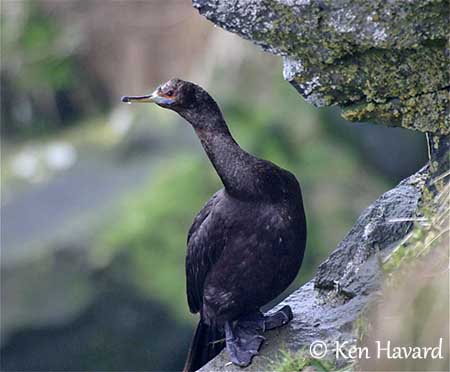
RANGE:
The Red-Faced Cormorant is found in Northern Pacific Ocean from NE Hokkaido (N Japan), E Kamchatka Peninsula, Kuril Islands and Commander Islands, E to Aleutian Islands, Pribilof Islands and Gulf of Alaska.
HABITAT:
The Red-Faced Cormorant is a marine species, spending most of its time in coastal waters, especially in rocky bays and straits between islands.
It breeds along the rocky coasts and on offshore islands, usually on rocky cliff ledges or on steep slopes.
CALLS AND SONGS: SOUNDS BY XENO-CANTO
The Red-Faced Cormorant gives low, guttural “kwoor” and hoarse croaking notes at colonies.
BEHAVIOUR IN THE WILD:
The Red-Faced Cormorant feeds primarily on fish of various species, and also takes crustaceans such as shrimps, crabs and amphipods.
Like numerous Phalacrocoracidae, it feeds by surface-plunging and pursuit-diving underwater. It uses the webbed feet to propel itself below the surface. Most of the preys are taken near the bottom.
The Red-Faced Cormorant breeds in mixed colonies with other seabird species. The male performs courtship displays with head over back and bill pointed skywards. The head is moved up and down while the folded wings are quickly raised and lowered, in order to display the white patches of the flanks.
During the nesting period, offering of nest materials to the incubating adult strengthens the pair-bonds.
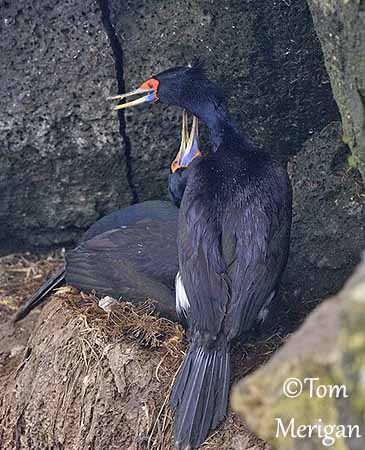
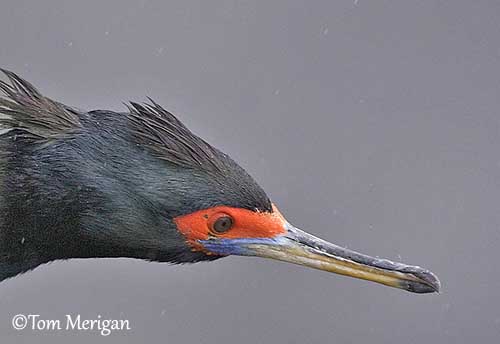
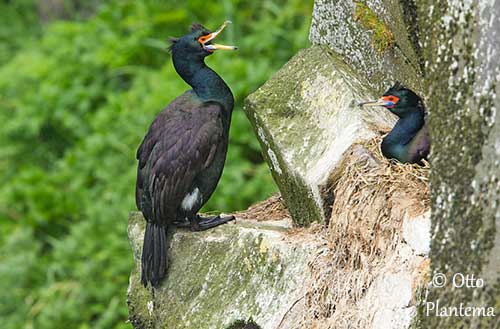
The Red-Faced Cormorant is sedentary, only dispersing over the nearby coast in the vicinity of the breeding areas where adults and immature birds forage during winter.
The flight is powerful with regular, continuous wingbeats interspersed with some glides. Over water, the bird usually flies low over the surface.
REPRODUCTION OF THIS SPECIES:
The breeding season takes place between May and August, with the egg-laying in May-June.
The Red-Faced Cormorant nests in colonies established on cliff ledges or steep slopes. The nest is fairly broad, and built with grass and seaweed cemented together with guano. Other materials such as moss and sticks may be added. There is a deep hollow in the centre, sometimes lined with feathers.
The female lays 2-4 eggs. The incubation lasts about 27-34 days, shared by both adults. The chicks have grey down. They are fed by regurgitation and fledge between 40 and 60 days after hatching.
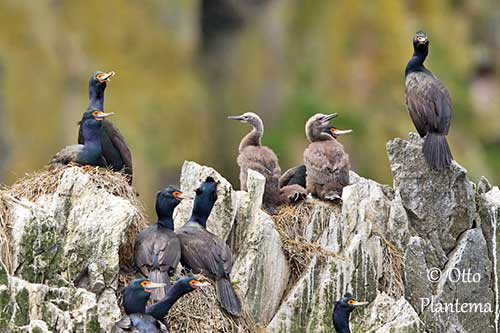
The nesting success depends on food availability in near-shore waters, because starvation is one of the main causes of mortality. Predation by Arctic foxes and destruction of nests by storms affect this species too.
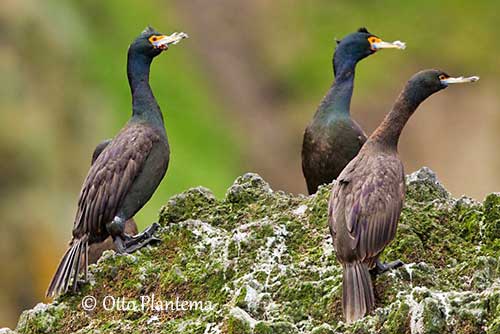
PROTECTION / THREATS / STATUS:
The Red-Faced Cormorant is vulnerable to oil spills and other pollutions, and predation by gulls, foxes and rats on some islands.
The population was estimated at 155,000/200,000 individuals in 2006, after an increase during the second half of the 20th century.
The Red-Faced Cormorant is currently evaluated as Least Concern.